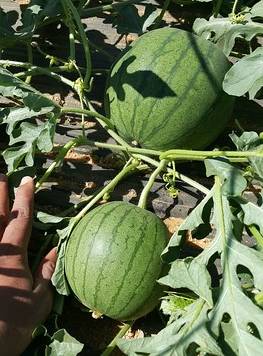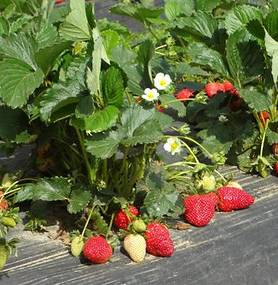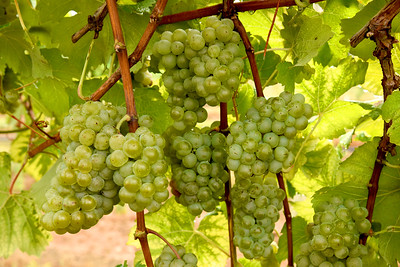Summer Fruit Gardening in Arkansas
Summer can be an opportune time to grow and harvest an array of fruits and vegetables. ‘Locally grown’ and ‘fresh from the garden’ are hot commodities nationwide. Many are beginning to grow their own gardens or are trying to buy locally from farmers markets.
What kinds of fruits are grown in Arkansas?
Fruit crops are typically divided into two categories—small fruits and tree fruits. In general small fruits are the easiest to incorporate into a home landscape, since they take up less space, and begin to fruit in a relatively short amount of time. For the most part, they also don’t need rigorous spray schedules.
All fruit crops need full sun and supplemental watering during dry periods. Fertilization schedules and pest problems vary by crop. Below is a list of popular summer fruits in Arkansas:

Figs are a member of the mulberry family (Moracae) and are related to many familiar houseplants including weeping fig (Ficus benjamina), rubber tree (Ficus elastica) and the fiddleleaf fig (Ficus lyrata). Our edible fig is the only hardy member of the Ficus genus and the only one that produces an edible fruit. If they suffer no winter damage, figs can reach a height of 25 or 30 feet tall and equally as wide. If space is limited they can be pruned to maintain a more reasonable size. Even if they do get frozen back to the soil line- they will typically re-sprout from the root system and may bear some fruit that year, since they do bear figs on the current season growth.
How to plant fig trees in Arkansas
Figs will produce best when planted in a well-drained soil in full sun. They have a fibrous, shallow root system which makes them sensitive to drought stress. If your fig tree gets too dry, it can drop fruit. Fruit drop can be caused by several things, including dry conditions, but also storms, cool weather soon after fruit set and weak trees. Our rollercoaster winter weather with swings in winter temperatures can lead to mild to severe winter injury-most commonly occurring in the northern counties in Arkansas. The further north you live in the state, the more protection the tree may need, but it still needs a minimum of 6 –8 hours of sunlight if you hope to harvest fruit. Planting on the east side of the house or with a rock or brick wall at their back to block the winds and radiate the heat will offer some protection from cold weather.

Melons are tender, warm-season edibles closely related to cucumbers and squash. Unlike squash and cucumbers which are eaten when they are immature fruits, melons require a longer growing season and are generally eaten when they are totally mature allowing the flesh to become sweet.
Melons can be grown in all parts of Arkansas. Melons are usually planted in the garden from late April through early June. Most gardeners plant them from seed, but these days, you can find transplants at local garden centers. Melons grow best in deep, well-drained, sandy loam soil with plenty of organic matter. Heavy soils with a lot of clay often cause small, weak plants that produce fewer melons. You need four things to grow melons: sun, bees, water, and space.
Many gardeners have avoided planting melons because of how much space they need to grow in. A standard melon patch can easily be twenty feet across or more. In the ground most gardeners plant watermelon plants 6-12 feet apart. If you don’t have that much real estate to devote to growing melons, you can grow them vertically.

Strawberries need well-drained soil and full sun. Hill up the rows and plant—planting on a small hill aids in drainage and can help with weed control. They can be planted in a stand-alone strawberry bed or planted to the side of your vegetable garden or flower bed.
Most commercial growers are now treating them as annuals, planting new crops each fall and harvesting in the spring and then using the ground for other crops. In home gardens, they are perennials, with larger plantings each year. They need to be thinned out after harvest to ensure healthy plants which aren’t too crowded. Fruit rots are more of an issue with overcrowding. Slugs can also be a challenge. There are many varieties to choose from with both “June-bearing” and “everbearing” types. Home gardeners tend to prefer the once a year “June-bearing” production types. For the “everbearing” you may have fruit over an extended period of time, but never enough to do anything with unless you have a lot of strawberry plants.
In Arkansas, the strawberry season usually starts in April and is over by early June depending on the variety.
For more information, download our publication Strawberry Production in the Home Garden

Most blueberries need another variety to cross-pollinate with to ensure fruit set. New self-fruitful varieties will produce better if there is another variety nearby. The three types of blueberries on the market are Highbush, which grow in the northern half of Arkansas, Rabbiteye for the southern half and the Southern Highbush which do well in central and southern Arkansas.
Blueberries need a well-amended, well-drained acidic soil, and they are not drought tolerant. Mulching and an irrigation system is a must. They are easy to incorporate into a garden as an edible ornamental, since they have showy white flowers in the spring, pretty, edible blue fruit in the summer and outstanding red fall foliage. They do produce a multi-stemmed bush with the mature height varying from 3 feet to 6 feet based on variety.
Best production is usually on three to four year old canes, but you want an even number of 1, 2, 3 and 4 year old canes for a long-producing plant. As canes get much older than four years, they tend to be woodier and less productive. Pruning of blueberries is done in the winter months when they are dormant. The biggest pest problem is birds—they love the fruit as much as you do. For a small home planting, bird netting is the best method for protection.
For more information, check out these resources:

Arkansas has long been the leading breeder of blackberry varieties and there is an impressive array of varieties to choose from.
Once you have harvested blackberries from a thornless plant, you will never want to pick from a thorny one again, even though there are some excellent thorny varieties. Give blackberries a spot in the garden where they can grow and expand, but be prepared to contain them as they begin to spread. By choosing your plants wisely you can start producing in late May and still be picking fruit in late July. Blackberries produce their fruit on the canes that grew last year. After you have finished harvesting, prune those fruiting canes out making room for the new canes which will have your crop next year. Keep the new canes pruned to a manageable height to aid in picking and to produce a fuller plant.
For more information, check out these resources:
Blackberry and Raspberry Production
AR Blackberry School - Management Activities for Each Season

There are several categories with table grapes, wine grapes and muscadines. Muscadines are the easiest of the grapes to grow, and require the least amount of maintenance. If you have a chain link fence or an arbor, new self-fruitful varieties can be planted and then sit back and harvest in late summer to early fall. A general pruning needs to be done annually before new growth begins. Table and wine grapes need a more precise spray schedule and usually a training or trellising system. All members of the grape family are prolific vine producers, so they do need annual pruning to keep producing at peak performance.
For more information, visit our page Home Garden Grapes and Muscadines
View a list of recommended varieties for each crop.
As with any type of gardening, start small and build on success. With proper selection
and care you can start harvesting some things this summer, but you can continue to
harvest for years to come.